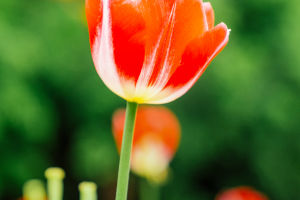Many people love fresh flowers, but the lifespan of fresh flowers is short. Whenever we receive flowers, we hope they can last longer, extending the joy and allowing us to immerse ourselves in affection for a few more days.
Three main techniques for caring for fresh flowers are trimming, removing excess leaves, and preserving.
1. Use a clean vase:
Make sure the vase used is clean. Clean the vase thoroughly each time you change the water, and ensure the water used is clear and fresh.
2. Trim the stems at an angle:
Before inserting the flowers into the vase, trim the stems again. When flowers are cut from plants, they form a "seal" at the "wound" to protect themselves. However, if this seal remains intact, it can hinder the flowers' water absorption from the vase, causing them to wilt quickly.
Additionally, bacteria can accumulate at the flower's "wound." By cutting the stems at a 45-degree angle, about 2-3 centimeters short, you reopen the seal and remove bacteria, ensuring the flowers can absorb water properly and last longer.
3. Remove excess leaves:
Some think plants' leaves aid photosynthesis and benefit flowers, even when placed in a vase. However, this is incorrect. Once cut from the plant, the leaves' photosynthetic function diminishes significantly, and they are no longer necessary in such abundance.
Moreover, excessive leaves can deplete nutrients and water, affecting the flowers' longevity. If leaves are submerged in water, they can rot and harbor bacteria, further shortening the flowers' lifespan. Therefore, after bringing flowers home, removing some leaves, especially those near the stem, is advisable to prolong the flowers' display period.
4. Feed the flowers:
Add appropriate flower preservatives. You can choose specialized flower preservatives and follow the instructions for use. To ensure optimal preservation, different flowers may require specific preservatives tailored to their needs, such as rose-specific or lily-specific preservatives.
Additionally, disinfecting and sterilizing the water can be achieved by adding substances like alcohol, potassium permanganate, camphor, borax, citric acid, salt, or alum, which can kill bacteria and prevent water from rotting. However, it's essential to dissolve these substances in water before use, and caution should be exercised to avoid adding too much, particularly with salt, to avoid creating overly concentrated solutions.
Flower bouquets can also be made into dried flowers:
When flowers in a bouquet start to wither, they can be turned into dried flowers for permanent preservation. There are various methods for making dried flowers, the simplest being natural air drying.
Before the flowers wilt entirely, remove them from the vase, pat them dry, remove any wilted or discolored leaves, and trim the stems at an angle. Hang them in a dry, warm indoor area to allow moisture to evaporate rapidly. Quick drying with hot air is preferable to prevent tissue shrinkage and preserve their natural color.
Hang the flowers upside down during drying to keep the stem tips rigid, either on wire or racks. Avoid using plastic bags, as they can promote mold growth. Dried flowers should be made on dry days. Leave longer stems and remove leaves, as leaves prolong dehydration and often become wrinkled, losing their decorative value. Large cut flowers should be hung individually for drying to prevent damage.
After several days, the cut flowers will gradually dry out, feeling brittle to the touch, with petals becoming fibrous. At this stage, they can be used for decoration.

